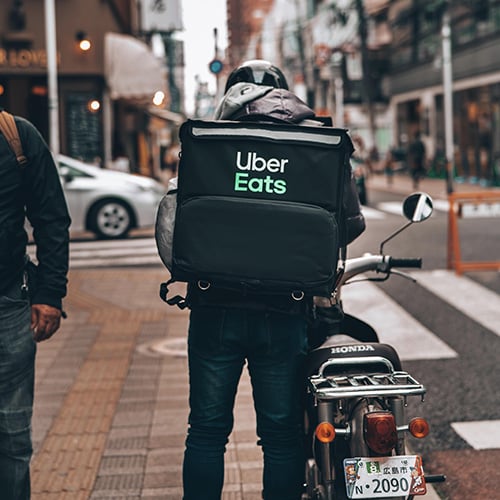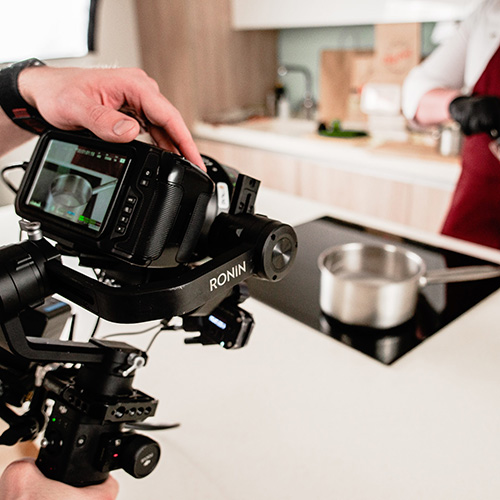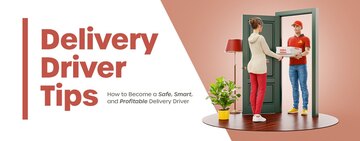As essential workers, foodservice professionals remained on the front lines of the pandemic. They sanitized and set to work, pioneering ways to care for customers from afar. As restaurants prepare to reopen, they can use the tactics that helped them survive to thrive in a post-pandemic world. From alternative delivery methods to creative business models, off premise dining innovations are here to stay.
Shop All Food Service Take-Out ContainersWhat Is Off Premise Dining?

Off premise dining, affectionately abbreviated to "off prem", is an umbrella term categorizing every dining experience that occurs beyond a permanent, physical building or its patio. Restaurants are serving customers off premise through innovative takeout and delivery methods. They're also adding off prem services such as video cook-alongs, meal subscriptions, and grocery outlets to boost their business. A brick and mortar isn't a prerequisite to foodservice operation anymore. There are off premise only concepts such as ghost kitchens, drive-in eateries, and pop-up restaurants.
Jump to the sections that most interest you by clicking the links below:
- Food Delivery
- Takeout Food
- Ghost Kitchens
- Commissary Kitchen
- Drive-in Restaurant
- Mobile Kitchen
- Online Ordering for Restaurants
- Meal Subscription Services
- Video Kitchen
- Restaurant Drive Thru Reimagined
- Pop-Up Kitchen
- The Grocery Restaurant
- Digital Makeline
- On Premise vs. Off Premise
Getting Off Premise: Emerging Trends
As we emerge from the pandemic, we enter an industry landscape where off premise dining is both a way to expand and conduct business. We’ve created a map of this new world, revealing how restaurants have and will operate beyond the confines of a physical location.
1. Food Delivery

Delivery became essential during the pandemic, and customers now expect restaurants to offer it. Creating an in-house delivery service has high startup fees, but thanks to third-party delivery services, any restaurant can offer delivery. A third-party delivery business cultivates a marketplace for customers to browse and order from partnered restaurants. Once the customer places their order, the third-party delivery service picks up the meal and takes it to them. Using a third-party delivery service markets your business and allows you to save on delivery service tools.
Setting up your own in-house delivery system is a good long-term investment that provides quality and profit control. According to Statista, four in five people blame the restaurant rather than the delivery service when their order goes wrong. Even worse, using third-party delivery services will cost you approximately 30% of your commissions. According to an Upserve study, 70% of third-party delivery service users would rather place their orders directly. Consumers want the restaurant to receive their full payment.
2. Takeout Food
Both takeout and delivery sales soared during the pandemic, but takeout orders exceeded delivery. Many patrons would rather drive to your business to pick up their order than pay a delivery service fee. In exchange, they expect a fast and efficient takeout system. Whether you’re using it for social distancing or speed, contactless carryout expedites pickup processes.
Create a designated curbside pickup area so customers can pick up their orders without exiting their vehicles. It’s helpful to have an app where customers can “check in” upon arrival and share their vehicle make, model, and color. Customers can also use the app to specify where they want their order placed. Alternately, you can set up a pickup station inside your restaurant where customers can grab their prepaid order without waiting in line. Investing in a heated, organized pickup station will maintain ideal serving temperatures.
Back to Top3. Ghost Kitchens
Ghost kitchens are restaurants that have no dining space or customer-facing storefront. They operate by selling food online and delivering patrons’ orders. As a relatively new concept, the rules of operating a ghost kitchen, and the terms used to define them, aren’t set in stone. Ghost kitchens are also known as virtual restaurants, dark kitchens, and delivery-only restaurants.
According to Technomic, ghost restaurant sales will rise by 25% each year. This will lead to an estimated $300 million in annual sales. Restaurateurs can integrate a ghost kitchen franchise into their brick and mortar. Adding a ghost kitchen franchise requires less work than developing your own takeout-friendly menu. It can also diversify your delivery options, reach new clientele, and increase your profits.
4. Commissary Kitchen
A commissary kitchen, also known as an incubator kitchen, is an established commercial kitchen space that foodservice providers pay to use. Commissary kitchens first emerged to meet the needs of the growing mobile vending market. The trend towards off prem dining has since spurned their growth. They are an ideal resource for ghost kitchens, pop-up kitchens, and can serve as a restaurant’s digital makeline space. In the Food Corridors 2020 follow-up study to their 2015 report, they saw a 40% increase in the number of shared kitchens.
There are multiple ways to use a commissary kitchen. If you can prepare your food at a set time each day, leasing a shared commissary kitchen space will save you money. If you plan to run a virtual restaurant out of your commissary kitchen, then leasing a private space is going to be the ideal choice for your needs. Small batch businesses would do well to rent a restaurant’s kitchen space during their off hours. Alternately, restaurant owners can rent their kitchen to earn extra cash. This is particularly advantageous for breakfast or dinner only establishments.
5. Drive-in Restaurant

A drive-in restaurant has a parking area where guests order, receive service, and dine inside their vehicle. Drive-in restaurants were a nearly extinct piece of Americana history, but social distancing orders revived the tradition. The last national drive-in chain, Sonic, is currently America’s favorite fast-food restaurant. According to a TopData report, Sonic's sales soured above venerable chains such as McDonald’s, Taco Bell, and Wendy’s during the COVID-19 pandemic.
Nostalgia and novelty are on your side for marketing, but you should modernize how your drive-in operates. Bygone drive-ins sold diner food, but modern drive-in restaurants can offer any cuisine. Unlike takeout, drive-in meals don't have to travel, so you can create a broad menu. If you allow customers to order online in advance, drive-ins are as convenient as curbside pickup.
6. Mobile Kitchen
The mobile kitchen sector encompasses food trucks, food trailers, and food carts. Each type of mobile kitchen provides unique opportunities and challenges. Adding a mobile kitchen concept is a great way to take your restaurant’s menu off prem. A mobile kitchen will help you cater private events, vend community events, and become a fixture at local sporting arenas.
Now is the time to get into the food truck business. Food trucks are the fastest growing sector of the foodservice industry, and IBISWorld report expects the food truck market will reach $1.1 billion in 2022. However, if you want a low startup cost mobile kitchen to build clientele and test out a few specialty items, a food cart is the ideal place to start. Alternately, a food trailer is a great off premise alternative to a brick and mortar. They allow you to provide a full menu and multiple course meals without having to rely on a commissary kitchen.
Back to Top7. Online Ordering for Restaurants
No matter the type of off prem dining experience you provide, people want to order their meals online. Toast revealed that online ordering systems earned a staggering $107.44 billion in 2019 worldwide. They predict that online ordering sales will reach $154.34 billion by 2023. Thankfully, you don’t have to be a technology expert to set up an online ordering system. There are multiple apps, forums, and third-party services that help restaurants set them up.
Your business will be more successful if you optimize your online ordering system for mobile. NPD Group research revealed consumers place 60% of all digital restaurant orders on mobile devices, and consumers would be more likely to become repeat online customers if you offer mobile ordering. Encourage potential customers to complete their order by condensing your menu to fit on the face of a phone.
8. Meal Subscription Services
Setting up meal subscription services at your restaurant is a fantastic way to establish consistent revenue. From 2017 to 2018 and long before the pandemic, the meal kit delivery services market grew 300% in a single year. While there are companies whose primary focus is meal subscriptions, restaurants can take advantage of the growing public interest as well. Rather than purchasing each meal a la carte and on a whim, patrons pay a monthly fee to have regular, full meals from your restaurant.
You’ll need to learn what your customers are looking for from their meal subscription. If they’re seeking total convenience, selling pre-made refrigerated and/or frozen meals portioned for either individuals or families is the ideal strategy. For customers who want an interactive meal subscription, you can sell meal kits loaded with your restaurant’s signature sauces and spices, helping them create chef-quality pizza, lettuce wraps, or tacos. However your customers want their meals, build loyalty by creating a signature unboxing experience and branded packaging for your meal subscription service.
9. Video Kitchen

Turn your restaurant’s back of house into a video kitchen and shoot live cooking classes or record video cook-alongs. This is a wonderful way to interact with off-site guests and increase your profits when selling meal kits. Appeal to the trend towards healthy, local, and organic meals by curating ingredients from local farms and gourmet grocers and then include the farmers and artisans in the video tutorial.
Depending on how many people take part, restaurants can earn between $800 and several thousand dollars per video session. Set the base participation price by evaluating your target audience and the type of food you’re preparing. An effortless way to increase that base price is by selling optional cocktail kits, bottles of wine, or desserts that complement the meal.
Back to Top10. Restaurant Drive Thru Reimagined
Drive thru lanes and fast food used to be exclusive, but the growing popularity of fast casual dining and the blurred lines between types of dining services has broadened drive thru applications. Drive thru only restaurants became a successful business model during the pandemic. Certain fast-food chains may choose to remain drive thru only.
Businesses with drive thru are updating their service to meet speed demands. Studies show people aren't willing to wait over four minutes in a drive thru line. Drive thru of the future will use online ordering so customers can order, pay, and schedule their pickup in advance. Online drive thru ordering moves faster and requires less labor than curbside pickup.
11. Pop-Up Kitchen

A pop-up kitchen, also known as a pop-up restaurant, is a food event that takes place at a temporary location for a limited amount of time. They allow chefs to test menu items and stoke the embers of public interest. Some pop-up kitchens set up and tear down in a single day, others are open for a few months. Pop-up kitchen events allow you to interact with your community without investing in a permanent location.
Prior to the pandemic, an Eventbrite study revealed pop-up kitchens were the fastest growing event type in the food and beverage category. As we look forward to regathering, pop-up kitchens will see a resurgence. You can partner with local bars and breweries and set up your pop-up kitchen on their premises. Another strategy is to set up your pop kitchen at a farmer’s market and create a menu with the ingredients sold by its vendors.
12. The Grocery Restaurant
Turn your restaurant into a mini mart. The grocery restaurant model allows customers to bring your gourmet ingredients home. This appeals to creative home chefs who want the freedom to reinvent your kitchen essentials for themselves. WiseGuyReports.com predicts the global specialty foods market will have a compound annual growth rate of 12.98% and reach $209.47 billion by 2023. By adding a specialty food market to your restaurant’s existing list of services, you can increase your profits and reach a new customer base.
Package and sell your specialty homemade sauces, spice blends, marinades, and dips. Fresh bread, pasta, and dessert are other popular choices. You can even sell gourmet pantry items like bottles of wine, olive oil, and balsamic vinegar. Prepare marinated steaks and seafood for patrons to grill at home, or ready to consume smoked meats, charcuterie snack boards, and artisanal cheeses.
13. Digital Makeline
A digital makeline is a second area for preparing online food orders. Dedicating kitchen space to digital business helps staff get delivery and takeout orders out in a timely manner. Since Chipotle implemented digital makelines, each unit has produced an average of $1 million in annual sales. Increasing your restaurant’s production capacity without adding dining space is a cost-effective way to expand your business. An efficient digital makeline frees your chefs and staff to create a one-of-a-kind in-house dining experience.
Back to TopOn Premise vs. Off Premise
To help you determine whether on premise or off premise focused business is right for you, we've broken down the advantages and disadvantages of each dining style below.
On-Premises Dining: Pros and Cons
- Menu Variety - Serving guests meals straight from your kitchen allows you to create a diverse menu without having to pair down on ingredients and focus on items that travel well.
- Alcohol Profits - Patrons ordering individually priced alcoholic drinks over the course of an evening earn on-premises dining establishments high profits.
- Customer Connection - On-premise dining allows you to connect with your patrons, get their feedback, and build a loyal base of repeat customers.
Off Premise Dining: Pros and Cons
- Low Operational Cost - Depending on your off premise business model, you can reduce or eliminate front-of-house labor costs. To put this into perspective, labor and food make up approximately 65% of operational fees for most on-premises restaurants.
- Higher Profits - 68% of restaurant operators see larger average check sizes on their off premise orders.
- Broadened Customer Base - Delivery and a strong online presence extend your reach beyond your immediate area.
The pandemic permanently linked off premise dining and foodservice. What began as a union of necessity has developed into an off premise industry ripe with opportunity. Whether your restaurant updates its methods for serving customers beyond its four walls or embarks on an entirely off premise business model, each expansion broadens your customer base.



